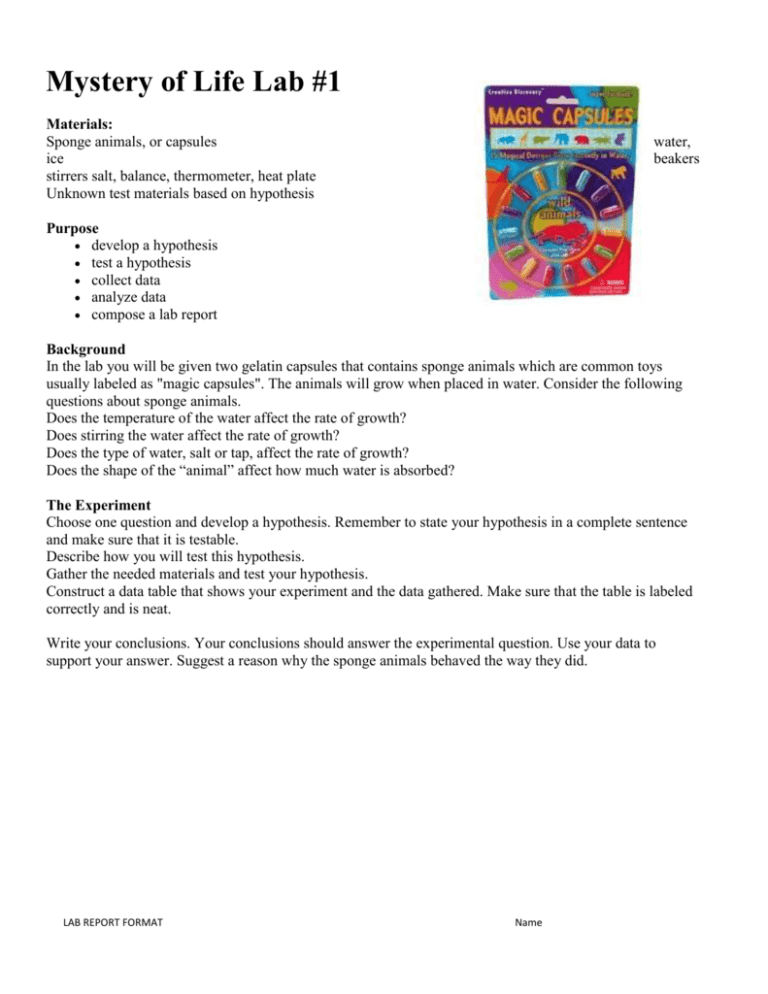Sponge animals, or capsules water, ice beakers
advertisement

Mystery of Life Lab #1 Materials: Sponge animals, or capsules ice stirrers salt, balance, thermometer, heat plate Unknown test materials based on hypothesis water, beakers Purpose develop a hypothesis test a hypothesis collect data analyze data compose a lab report Background In the lab you will be given two gelatin capsules that contains sponge animals which are common toys usually labeled as "magic capsules". The animals will grow when placed in water. Consider the following questions about sponge animals. Does the temperature of the water affect the rate of growth? Does stirring the water affect the rate of growth? Does the type of water, salt or tap, affect the rate of growth? Does the shape of the “animal” affect how much water is absorbed? The Experiment Choose one question and develop a hypothesis. Remember to state your hypothesis in a complete sentence and make sure that it is testable. Describe how you will test this hypothesis. Gather the needed materials and test your hypothesis. Construct a data table that shows your experiment and the data gathered. Make sure that the table is labeled correctly and is neat. Write your conclusions. Your conclusions should answer the experimental question. Use your data to support your answer. Suggest a reason why the sponge animals behaved the way they did. LAB REPORT FORMAT Name Date TITLE I. Question: What are you trying to find out? (One sentence) II. Hypothesis: A. Background information: (In a flowing paragraph) What do you need to know before you begin the lab? Are their certain facts, vocabulary or observations that you need to discuss so you can inform the reader of vital information so they understand your lab? B. Hypothesis Question: What question are you going to answer? This should be answered by the data you will collect (qualitative and quantitative). C. Hypothesis Statement: Complete the sentence: If we (I) ____________________________ (describe what you are doing), then I predict _________________________________(predict an answer to the question you just posed) because ____________________(why do you think it will be this way—based on your background information). III. Procedure A. Materials (in a numbered list) 1. 2. 3. (and so on) B. Methods: Your steps must be repeatable (a very specific numbered lit of repeatable steps and safety precautions) 1. 2. 3. (and so on) IV. Observations and Data A. Make a Data Table 1. Title your data table 2. Label columns and rows if necessary 3. Use SI Units 4. Qualitative and Quantitative Data a. Make a data table that incorporates both types of data b. Make a separate data table for each type of data. B. Sketches and Observations 1. Use sketches when appropriate to describe steps or results of your experiment. 2. For long term experiments (+1 week), a journal or observation book for qualitative data may be required. C. Graph 1. Graph the quantitative data from your data table into a graph. 2. Title, label X and Y axis (independent and dependent—respectively) and use SI units. 3. Use a line graph, bar graph or scatter plot graph—all graph should be done on excel or graph paper. V. Analysis and Conclusion (IN A FLOWING PARAGRAPH) What did you find out? (support with data tables and graphs) What patterns in the data did you see? (what does this mean) Was your hypothesis supported or not supported? Why? Sources of Error? (What did you do wrong?) Limitations (What things went wrong and were out of your control?) How could you redesign this lab and make it better? How could you extend this lab to learn more?






